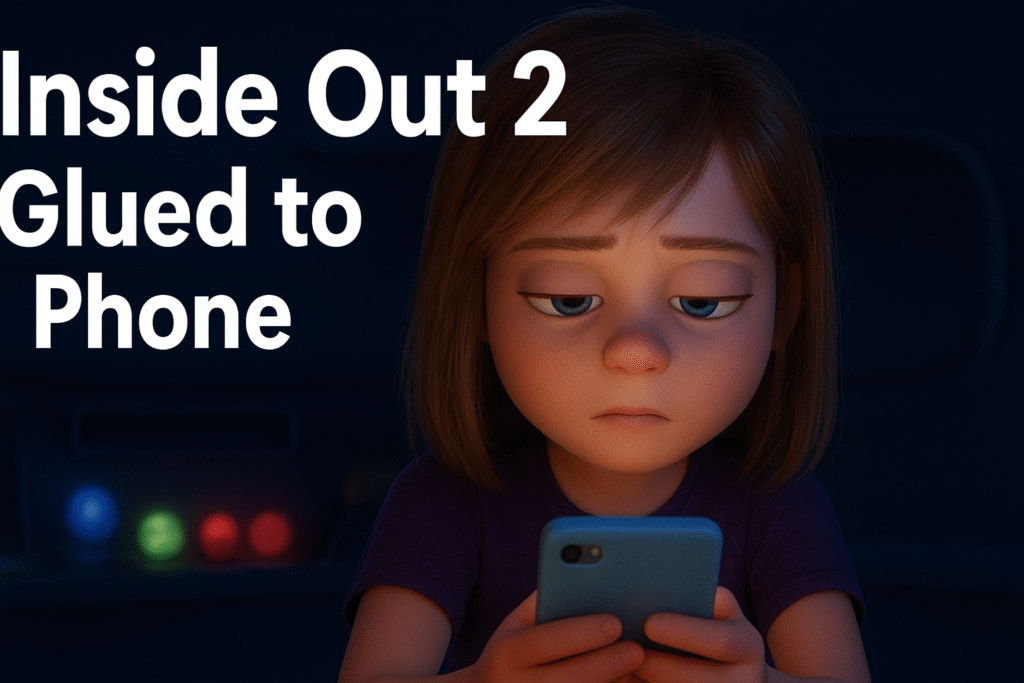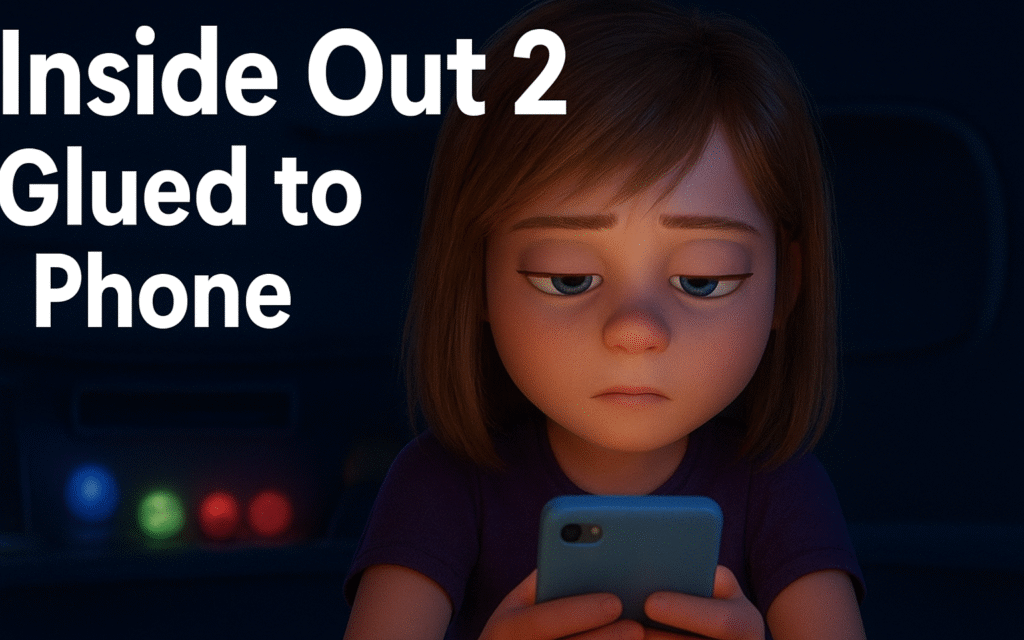Table of Contents
Introduction to the article inside out 2 glued to phone
inside out 2 glued to phone. Glued to Phone has managed to captivate and irritate audiences worldwide. This sequel is no longer focused on the interior emotional problems of a young girl; instead, it explores the implications of living life in an increasingly digital world. Still, the colorful exterior of the sequel hides a severe and troubling message about technology addiction that needs to be addressed. As children of this generation become more attached to their technology, the personal becomes the societal.
The colorful characters we learned to adore in the 1st movie face the new societal problems of overwhelming screen time and connectivity. The movie opens a new discussion about the priorities that families and educators should be fostering, reminding them to stay present and not to let the digital world take control of their lives. In this post, we discuss the storyline of Inside Out 2: Glued to Phone and the implications it has on children today in relation to technology.
Recap of the first inside out 2 glued to phone

inside out 2 glued to phone, sub-titled “Glued to Phone”, continues the story of Riley. She is a teenager now, and the film shows the challenges of adolescence and navigating Riley’s teen years.
In the sequel, the emotions, which are still Joy, Sadness, Anger, Fear, and Disgust, take on Riley’s obsession with technology. Each of Riley’s emotions is incredibly challenged by the clouded and frantic, always-changing, emotional landscape of Riley’s adolescence, which is now deeply influenced by social media.
When distractions from screen time are so dominant, the emotional distraction is muted. Joy feels the pressure of maintaining the emotional balance more than ever, and just the balance and equilibrium she attempts to maintain are clouded and distracted by the grief and violence of her emotions.
inside out 2 glued to phone, glowing distraction, which was so dominant in Riley’s mind, was removed; the vibrant colors signifying joy in the emotions were muted. No more vibrant emotions, nor vibrant relationships, and with the phone came a decline in the self-worth of Riley, and the glowing distraction was then the dominant relationship. It is a story of the modern childhood digitally influenced.
The rise of technology addiction among children inside out 2 glued to phone
inside out 2 glued to phone, use of technology and its addictive qualities are quite common among children during this digital era. Uninterrupted access to communication and entertainment technology draws children away from real-world social networking. Inside Out 2 demonstrates this digital imbalance very effectively and shows how emotional instability and excessive technology use come together and tear the inner emotional world apart. Many homes and families can relate to the film as it shows children excessively absorbed in their entertainment technology and ignoring the real world.
inside out 2 glued to phone technology entertainment for excessive periods of time is associated with developing anxiety and depression, as well as problems with social withdrawal and unwillingness to deal with the outside world. These entertainment technologies have become a default option for children to use and have become a way to maintain their social relational systems.
Inside Out 2 articulates the void digital technology leaves in child development very effectively and resonates with most parents. Explaining the negative psychological and social consequences of such screens is essential in today’s world.
Analysis of the storyline in Inside Out 2 and its portrayal of technology addiction
inside out 2 glued to phone, excessive attachment to her phone. ”Inside Out 2” tracks her emotional journey as a 21st-century modern teenage girl.This isn’t just a minor detail of her character; it is indicative of a much larger concern. The film handles the impact … the absence of technology. Joy and Sadness battle to get the social media user’s attention away from the notifications and the mindless scrolling. This quest is like many modern children’s. They become lost in an emotional wasteland of digital distractions.
The loss of a phone and other digital distractions is so silent that a child cannot even realize the joy it offered in the past. This loss explains Sadness. This is an important message for all youths across the globe. They face digital screens in their everyday lives.
Impact on children and how it reflects society’s
relationship with technology
inside out 2 glued to phone highlights the consequences of “over the top” technology use on children, specifically the emotional impact. Children who become enthralled by their phones miss deep interactions with people around and lose profound face-to-face communication.
The increase in unformed in-person conversations takes a toll and adds to anxiety and loneliness.
. Children need your help to build deep relationships. Almost all kids today use technology in excess.. These are the moments that the film captures, showing the reality of the relationships built around and facilitated by screens. inside out 2 glued to phone of our technology engagement is paradoxical; while we use our phones to acquire information and maintain relationships, we disregard real-life, silent interactions. Parents, in their effort to keep children entertained, lose touch with the reality of family engagement and caring.
The emotion regulation challenges children face in real life might be because of the relationships they have built with screens. This reality of technology engagement points to the need for balance between increasing screen time and the changing accepted norms around its use.
The responsibility of parents in managing their child’s screen time
inside out 2 glued to phone; their children understand their relationship with technology. Everything starts with talking about screen time and how it affects everyday life. Amid endless distractions, children need assistance in developing strong boundaries. By designating specific hours for technology, children have the opportunity to explore their immediate physical environments and avoid getting lost in the digital world.
Healthy boundaries must also be demonstrated. When children see their caregivers partaking in offline interests, it increases the chances that they will also take part in offline interests. Allowing children to speak about their feelings on technology will enhance their understanding. Ask how technology alters their feelings and how it compares to real in-person interactions.
Parents improve family time by designating technology-free zones within the home. The silence drives reconnection and, most importantly, fosters complete, well-balanced, social, physical, and mental growth. There is the ability to promote connection and not simply consumption when the above suggestions are consistently followed.
Suggestions for a healthy balance between technology use and real-life experiences
inside out 2 glued to phone; some areas in the home as off-limits. This could include the dining rooms or bedrooms. Having ongoing, natural discussions helps develop and maintain relationships and strengthens positive, productive communication. For positive emotional development, engage in outdoor team activities. Plan family bonding activities too. Bike rides, nature hikes, or even walks around the neighborhood are all great options. There is something very relaxing about fresh air, and these activities provide some exercise.
Set routines as to when devices can be used. Organize a plan whereby screen time for activities, assignments, and family time is balanced. This demonstrates to your children when it is time to screen fasten.
Support emotional and physical development by enjoying time outside together. You could plan some family outdoor time together. A bike ride, hike, or stroll around the block are all excellent outdoor activities.
Being in the fresh air is a great way to clear your mind. Provide kids with some non-screen activities. Kids can replace some of their hobby screen time and still have a blast. Gardening, painting, or playing a musical instrument are also activities that can be rewarding and give a challenge. Show your family balanced screen time habits. Kids learn by observing; therefore, your home screen time habits will be mirrored by them.
Conclusion: inside out 2 glued to phone
inside out 2 glued to phone***Inside Out 2: Glued to Phone*** opens important discussions on the role technology plays in young, developing minds and family relationships. In a world where children are ever more attached to their devices to the point where the devices replace relationships, emotional growth becomes stunted. The film amplifies children’s attention challenges during screen time and the struggles to pull them away to attend to other activities. Tech hallucinations and relationships reshaping addiction layers add to the additional struggles the child faces daily, and parental recognition becomes all the more critical.
The ongoing tension in society- partially due to the pandemic – makes the socio-emotional and psychological toll of unregulated screen use more important than ever. Parents, through active discussions and device-free family time, can support a child-development-focused screen use for technology while improving balanced, real-world experiences.
inside out 2 glued to phone time beyond family obligations, through a variety of other activities, strengthens emotional and socio-psychological growth. Providing time for outdoor, family, and individual activities, hobbies, and other forms of play will develop the neglected social and emotional intelligence that must be achieved to replace the screens, devices, and technology. Discussing these topics in “Inside Out 2: Glued to Phone” allows us to make sense of our lives and our lives with our kids in the digital world.
